

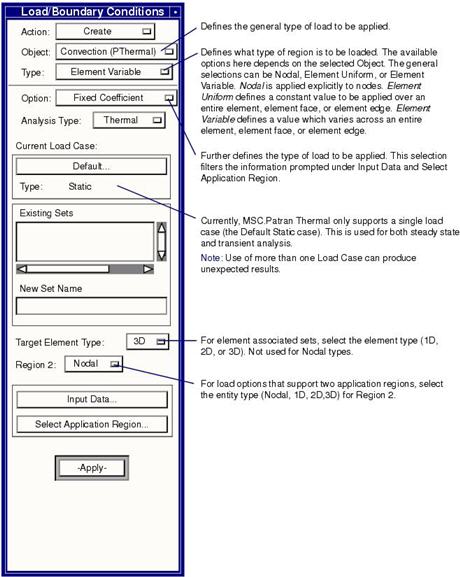
Object | Type | Option |
• Nodal | • Fixed • Time Table • Coupled • Initial • Template | |
• Element Uniform • Element Variable | • Flux, Fixed | |
• Element Uniform | • Flux, Time Table • Flux, Temperature Table | |
• Element Uniform • Element Variable | • Template, Fluxes • Template, Volumetric Heat | |
• Nodal | • Template, Nodal Source | |
• Element Variable | • Flux, Spatial Field (Time) | |
• Element Uniform • Element Variable | • Fixed Coefficient | |
• Element Uniform | • Time Table • Temperature Table | |
• Element Uniform • Element Variable • Element Variable | • Template Convection • • Spatial Field (Time) | |
• Element Uniform • Element Variable | • Ambient Node | |
• Element Uniform • Element Variable | • Gap Radiation • | |
• Element Uniform | • Template ViewFactors | |
• Element Uniform | • Spacecraft, STEP_TAS | |
• Pressure | • Nodal | • Fixed • Time Table • Initial • Template |
• Nodal | • Fixed • Time Table • Initial • Template |
Object | Option | LBC ID Variable Name |
• Fixed • Time Table • Coupled • Initial • Template | • LBC_PTH_TEMP_TIME_TABL_ID • LBC_PTHERMAL_TEMP_FIXD_ID • LBC_PTHERMAL_TEMP_COUP_ID • LBC_PTHERMAL_TEMP_INIT_ID • LBC_PTHERMAL_TEMP_TMPL_ID | |
• Flux, Fixed | • LBC_PTH_HEAT_FLUX_FIXD_ID | |
• Flux, Time Table • Flux, Temperature Table | • LBC_PTH_HEAT_FLUX_TIME_TABL_ID • LBC_PTH_HEAT_FLUX_TEMP_TABL_ID | |
• Template, Fluxes • Template, Volumetric Heat | • LBC_PTHERMAL_HEAT_TMPL_FLUX_ID • LBC_PTHERMAL_HEAT_TMPL_VOLH_ID | |
• Template, Nodal Source | • LBC_PTHERMAL_HEAT_TMPL_NODS_ID | |
• Flux, Spatial Field (Time) | • LBC_VAR_PTH_FIELD_NAME | |
• Fixed Coefficient | • LBC_PTH_CONV_FIXD_ID | |
• Time Table • Temperature Table | • LBC_PTH_CONV_TIME_TABL_ID • LBC_PTH_CONV_TEMP_TABL_ID | |
• Template Convection | • LBC_PTHERMAL_CONV_TMPL_ID | |
• Spatial Field (Time) | • LBC_VAR_PTH_FIELD_NAME | |
• Ambient Node • Gap Radiation • Template ViewFactors • Spacecraft, STEP_TAS | • LBC_PTH_RADI_AMBN_ID • LBC_PTHERMAL_RADI_GAP_ID • LBC_PTHERMAL_RADI_TMPL_ID • LBC_PTH_RADI_STAS_ID | |
• Pressure | • Fixed • Time Table • Initial • Template | • LBC_PTHERMAL_PRES_FIXD_ID • LBC_PTH_PRES_TIME_TABL_ID • LBC_PTHERMAL_PRES_TMPL_ID • LBC_PTHERMAL_PRES_INIT_ID |
• Fixed • Time Table • Initial • Template | • LBC_PTHERMAL_MDOT_FIXD_ID • LBC_PTH_MDOT_TIME_TABL_ID • LBC_PTH_MDOT_GEN_FUNC_ID • LBC_PTHERMAL_MDOT_INIT_ID |
LBC ID | LBC Load Type |
• 51 | • Temperature (PThermal)[Fixed] |
• 52 | • Temperature (PThermal)[Time Table] |
• 54 | • Temperature (PThermal)[Coupled] |
• 55 | • Temperature (PThermal)[Initial] |
• 56 | • Temperature (PThermal)[Template] |
• 60 | • Heating (PThermal)[]Flux, Fixed |
• 61 | • Heating (PThermal)[Flux, Time Table] |
• 62 | • Heating (PThermal)[Flux, Temperature Table] |
• 67 | • Heating (PThermal)[Template, Fluxes] |
• 68 | • Heating (PThermal)[Template, Volumetric Heat] |
• 69 | • Heating (PThermal)[Template, Nodal Source] |
• 70 | • Heating (PThermal)[Flux, Spatial Field(Time)] |
• 101 | • Convection (PThermal)[Fixed Coefficient] |
• 102 | • Convection (PThermal)[Time Table] |
• 103 | • Convection (PThermal)[Temperature Table] |
• 105 | • Convection (PThermal)[Template, Convection] |
• 107 | • Convection (PThermal)[Spatial Field(Time)] |
• 109 | • Radiation (PThermal)[Ambient Node] |
• 110 | • Radiation (PThermal)[Gap Radiation] |
• 112 | • Radiation (PThermal)[Template, View Factors] |
• 113 | • Radiation (PThermal)[Spacecraft, STEP_TAS] |
• 116 | • Pressure (PThermal)[Fixed] |
• 117 | • Pressure (PThermal)[Time Table] |
• 119 | • Pressure (PThermal)[Initial] |
• 120 | • Pressure (PThermal)[Template] |
• 124 | • Mass Flow Rate (PThermal)[Fixed] |
• 125 | • Mass Flow Rate (PThermal)[Time Table] |
• 127 | • Mass Flow Rate (PThermal)[Initial] |
• 128 | • Mass Flow Rate (PThermal)[Template] |
Object | Option | LBC ID |
• Fixed • Time Table • Coupled • Initial • Template | • 51 • 52 • 54 • 55 • 56 | |
• Flux, Fixed • Flux, Time Table • Flux, Temperature Table • Template, Fluxes • Template, Volumetric Heat • Template, Nodal Source • Flux, Spatial Field (Time) | • 60 • 61 • 62 • 67 • 68 • 69 • 70 | |
• Fixed Coefficient • Time Table • Temperature Table • Template Convection • Spatial Field (Time) | • 101 • 102 • 103 • 105 • 107 | |
• Ambient Node • Gap Radiation • Template ViewFactors • Spacecraft, STEP_TAS | • 109 • 110 • 112 • 113 | |
• Pressure | • Fixed • Time Table • Initial • Template | • 116 • 117 • 119 • 120 |
• Fixed • Time Table • Initial • Template | • 124 • 125 • 127 • 128 |
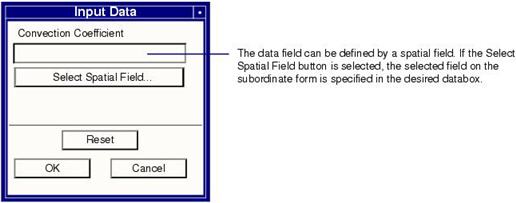
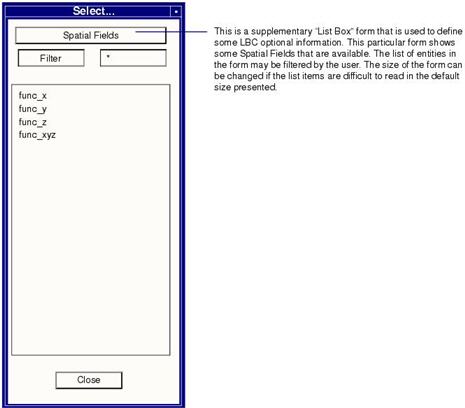
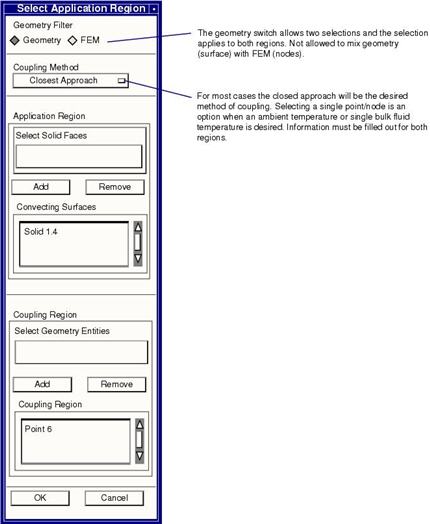
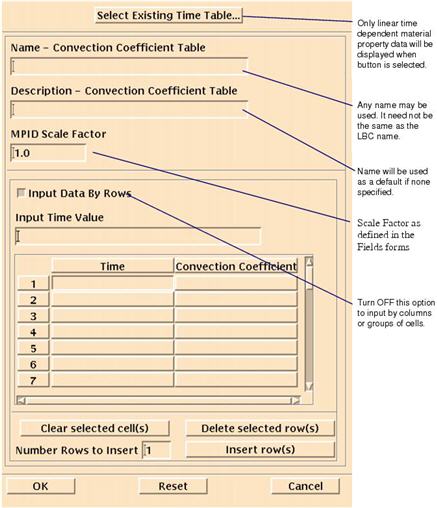
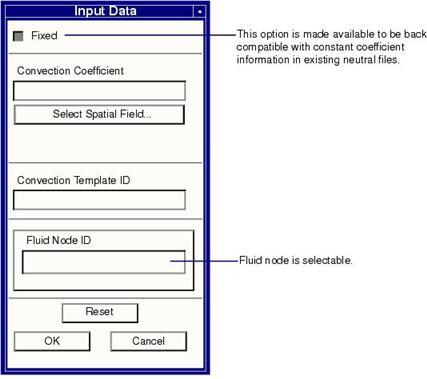
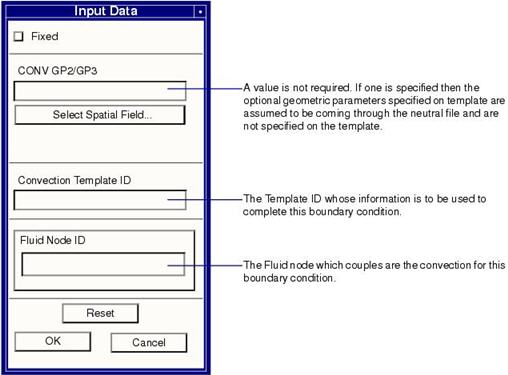
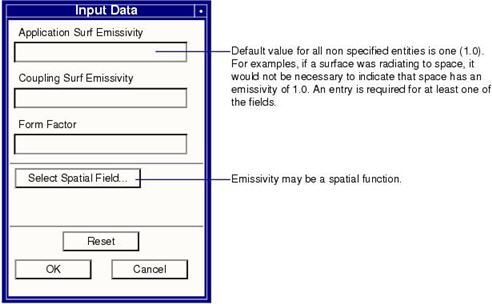
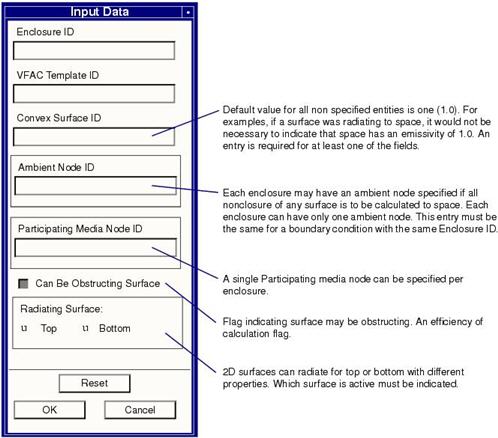
LBC | Type of Data | Template Required | Fields Referenced |
• Temperature | • Constant or Spatial Field | • | • |
• Time dependent | • Non-Spatial/General | ||
• Heating | • Constant or Spatial Field | • | • |
• Time or Temperature | • Non-Spatial/General | ||
• Convection | • Constant or Spatial Field | • | • |
• Time or Temperature | Note: Use Config 29 | • Material Prop/General | |
• Correlations Library | • Material Prop/General | ||
• Radiation | • Viewfactor code data | • Material Prop/General | |
• TRASYS Preference | • | ||
• NEVADA Preference | • | ||
• Pressure | • Constant or Spatial Field | • | • |
• Time or Temperature | • Non-Spatial/General | ||
• Mass Flow | • Constant or Spatial Field | • | • |
• Time or Temperature | • Non-Spatial/General |
Object | Type | Option |
Temperature | Nodal | Fixed |
Input Data | Description |
Temperature | Temperature (value or spatial field) that remains fixed in the analysis. |
Object | Type | Option |
Temperature | Nodal | Time Table |
Input Data | Description |
Name | Micro Function name that Table will be stored under in the general fields. |
Description | Definition of Table. |
Time Temperature | Data pairs which define a bounded linear table which specifies temperature as a function of time. |
Object | Type | Option |
Temperature | Nodal | Initial |
Input Data | Description |
Temperature | Initial temperature (value or spatial field). If the entire model has the same initial temperature, set the global value under Analysis/Solution_Parameters/Run control Parameters. |
Object | Type | Option |
Temperature | Nodal | Coupled |
Input Data | Description |
<No Input Data> | Usage: This option only uses Select Application Regions to define the primary application region and the companion region that will be thermally coupled. This option can be used to couple topologically non-congruent meshes, to model cyclical symmetry or to tie nodes in mixed 3D and axisymmetric models. The entities will be coupled based on a Selection order or Closest Approach, as chosen. To maintain accurate transient effects, the thermal capacitance of the node in the companion region will include the capacitance of the node in the primary application region. |
Object | Type | Option |
Temperature | Nodal | Template |
Input Data | Description |
Temperature | Scale factor on temperature returned from template evaluation. |
Template ID | Positive template ID points into template.dat file. |
Object | Type | Target | Option |
Convection | Element Uniform Element Variable | 1D, 2D, 3D | Template, Convection |
Input Data | Description |
Convection Coefficient | Convective heat transfer coefficient or a geometric property if template ID is used. |
Convection Template ID | Positive integer, points convection template in template.dat file. |
Fluid Node ID | The node ID to which the heat is convected. |
Object | Type | Target | Option |
Convection | Element Uniform Element Variable | 1D, 2D, 3D Nodal,1D,2D,3D | Fixed Coefficient |
Input Data | Description |
Convection Coefficient | Heat transfer coefficient (constant or spatial field). Correlations library not allowed in this option. The corresponding area for convection will be based on application region 1 entities. This boundary condition is useful for connecting dissimilar meshes with thermal resistance in between or for tying a surface to a fluid stream. Convection between regions can be applied to 1D elements for 2D thermal or axisymmetric elements. Currently not supported for 1D elements in 3D space. |
Note: | Filter must be the same (either Geometry or FEM) on both application regions. |
Object | Type | Target | Option |
Heating | Element Uniform Element Variable | 1D, 2D, 3D | Template, Fluxes |
Input Data | Description |
Heat Flux | Heat flux value or a scale factor if template ID is used. |
Template ID | Positive integer, points heat macro in template.dat file. |
Object | Type | Option |
Heating | Nodal | Template, Nodal Source |
Input Data | Description |
Heat Source | Nodal heat source or a scale factor if template ID is used. |
Template ID | Positive integer, points macro in template.dat file. |
Object | Type | Target | Option |
Heating | Element Uniform Element Variable | 1D, 2D, 3D | Template, Volumetric Heat |
Input Data | Description |
Heat Source | Volumetric heat source or scale factor if template ID is used. |
Template ID | Positive integer, points macro in template.dat file. |
Object | Type | Option |
Pressure | Nodal | Template, Fixed, Initial |
Input Data | Description |
Pressure | Nodal pressure or scale factor if template ID is used. |
Template ID | Positive integer, points pmacro in template.dat file. |
Object | Type | Option |
Mass Flow | Nodal | Template, Fixed, Initial |
Input Data | Description |
Mass Flow Rate | Nodal mass flow node or scale factor is template ID is used. |
Template ID | Positive integer, points mmacro in template.dat file. |
Object | Type | Target | Option |
Radiation (PThermal) | Element Uniform Element Variable | 1D, 2D, 3D Nodal, 1D, 2D, 3D | Gap Radiation |
Input Data | Description |
Surface 1 Emissivity | Emissivity value or spatial field for application region 1. |
Surface 2 Emissivity | Emissivity value or spatial field for companion region 2 (default = 1). |
Form Factor | Viewfactor value applied to the radiation couplings (default = 1). |
Note: | Filter must be the same (either Geometry or FEM) on both application regions. |
Object | Type | Target | Option |
Radiation | Element Uniform | 1D, 2D, 3D | Viewfactor |
Input Data | Description |
Enclosed ID | Enter radiation enclosure ID. |
Template ID | Positive Integer points to VFAC, VTRA or VNEV data in template .dat file. |